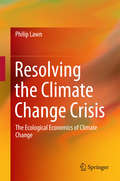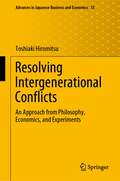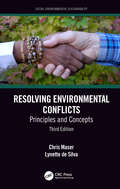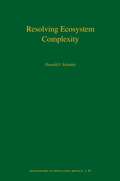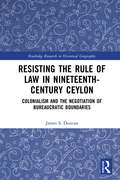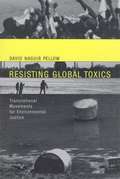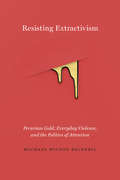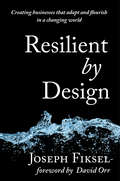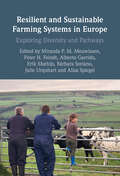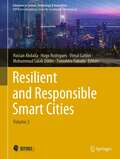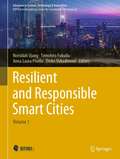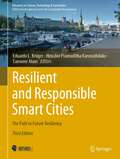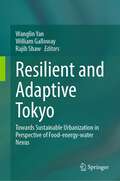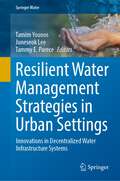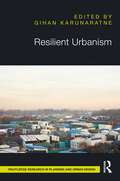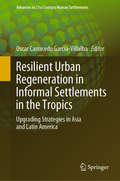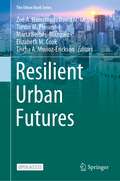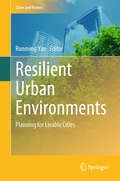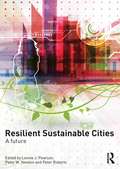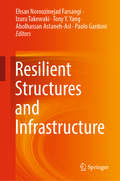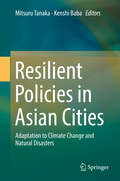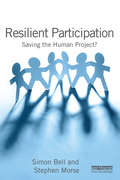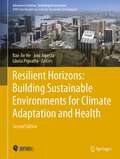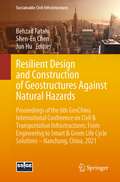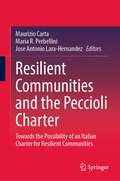- Table View
- List View
Resolving the Climate Change Crisis
by Philip LawnThis book explains why the climate change crisis is a symptom of a much larger underlying problem - namely, humankind's predilection with continuous GDP-growth. Given this starting point, the world's high-income nations must begin the transition to a qualitatively-improving steady-state economy and low-income nations must follow suit at some stage over the next 20-40 years. Unless they do, a well-designed emissions protocol will be as useless as the paper it is written on. Adopting an ecological economic approach, this book sets out why we must abandon the goal of continuous growth; how we can do so in a way that improves human well-being; what constitutes a safe atmospheric concentration of greenhouse gases; and what type of emissions protocol and emissions-trading framework is likely to achieve a desirable climate change outcome. Failure of the world's leaders to achieve these goals will not only put future human well-being at risk, it will threaten freedom in the liberal-democratic tradition and international peace.
Resolving Intergenerational Conflicts: An Approach from Philosophy, Economics, and Experiments (Advances in Japanese Business and Economics #33)
by Toshiaki HiromitsuThis book is an unprecedented consideration of the challenges of what we can do for generations yet to come. Many growing intergenerational conflicts of interest, such as climate change and fiscal sustainability, are the result of the historically new progress of increasing human power, and the resolution of those conflicts demands a new intergenerational ethic. The book offers fresh new ideas for resolving intergenerational conflicts through the exploration of an entirely new field, conceptualized in philosophy, developed in economics, and tested in experiments. In particular, this work develops the theory of intergenerational cooperation based on a new relationship of direct reciprocity between generations. From experimental results, the possibility of intergenerational cooperation through Kantian categorical imperative is shown. The book also examines the effectiveness of inviting representatives of future generations, which are called "imaginary future generations", into the deliberations for current policy decisions. The original Japanese edition of this book was awarded the 66th Nikkei Prize for Excellent Books in Economic Science. The prize was established in 1958 to contribute to the advancement of academics and knowledge in the fields of economics, management, and accounting, as well as to its general dissemination and application.
Resolving Environmental Conflicts: Principles and Concepts, Third Edition (Social Environmental Sustainability)
by Chris Maser Lynette de SilvaResolving a conflict is based on the art of helping people, with disparate points of view, find enough common ground to ease their fears, sheath their weapons, and listen to one another for their common good, which ultimately translates into social-environmental sustainability for all generations. Written in a clear, concise style, Resolving Environmental Conflicts: Principles and Concepts, Third Edition is a valuable, solution-oriented contribution that explains environmental conflict management. This book provides an overview of environmental conflicts, collaborative skills, and universal principles to assist in re-thinking and acting toward the common good, integrates a variety of new real-world conflicts as a foundation for building trust, skills, consensus, and capacity, and explains pathways to collectively construct a relationship-centric future, fostering healthier interactions with one another and the planet. The new edition illustrates how to successfully mediate actual environmental disputes and how to teach conflict resolution at any level for a wide variety of social-environmental situations. It adds a new chapter on water conflicts and resolutions, providing avenues to healthy, sustainable, and effective outcomes and provides new examples of conflicts caused by climate change with discussion questions for clear understanding. Land-use planners, urban planners, field biologists, and leaders and participants in collaborative environmental projects and initiatives will find this book to be an invaluable resource. University students in related courses will also benefit, as will anyone interested in achieving greater social-environmental sustainability and a more responsible use of our common natural resources for themselves and their children.
Resolving Ecosystem Complexity (Monographs in Population Biology #47)
by Oswald J. SchmitzAn ecosystem's complexity develops from the vast numbers of species interacting in ecological communities. The nature of these interactions, in turn, depends on environmental context. How do these components together influence an ecosystem's behavior as a whole? Can ecologists resolve an ecosystem's complexity in order to predict its response to disturbances? Resolving Ecosystem Complexity develops a framework for anticipating the ways environmental context determines the functioning of ecosystems. Oswald Schmitz addresses the critical questions of contemporary ecology: How should an ecosystem be conceptualized to blend its biotic and biophysical components? How should evolutionary ecological principles be used to derive an operational understanding of complex, adaptive ecosystems? How should the relationship between the functional biotic diversity of ecosystems and their properties be understood? Schmitz begins with the universal concept that ecosystems are comprised of species that consume resources and which are then resources for other consumers. From this, he deduces a fundamental rule or evolutionary ecological mechanism for explaining context dependency: individuals within a species trade off foraging gains against the risk of being consumed by predators. Through empirical examples, Schmitz illustrates how species use evolutionary ecological strategies to negotiate a predator-eat-predator world, and he suggests that the implications of species trade-offs are critical to making ecology a predictive science. Bridging the traditional divides between individuals, populations, and communities in ecology, Resolving Ecosystem Complexity builds a systematic foundation for thinking about natural systems.
Resisting the Rule of Law in Nineteenth-Century Ceylon: Colonialism and the Negotiation of Bureaucratic Boundaries (Routledge Research in Historical Geography)
by James S. DuncanThis book offers in-depth insights on the struggles implementing the rule of law in nineteenth century Ceylon, introduced into the colonies by the British as their “greatest gift.” The book argues that resistance can be understood as a form of negotiation to lessen oppressive colonial conditions, and that the cumulative impact caused continual adjustments to the criminal justice system, weighing it down and distorting it. The tactical use of rule of law is explored within the three bureaucracies: the police, the courts and the prisons. Policing was often “governed at a distance” due to fiscal constraints and economic priorities and the enforcement of law was often delegated to underpaid Ceylonese. Spaces of resistance opened up as Ceylon was largely left to manage its own affairs. Villagers, minor officials, as well as senior British government officials, alternately used or subverted the rule of law to achieve their own goals. In the courts, the imported system lacked political legitimacy and consequently the Ceylonese undermined it by embracing it with false cases and information, in the interests of achieving justice as they saw it. In the prisons, administrators developed numerous biopolitical techniques and medical experiments in order to punish prisoners’ bodies to their absolute lawful limit. This limit was one which prison officials, prisoners, and doctors negotiated continuously over the decades. The book argues that the struggles around rule of law can best be understood not in terms of a dualism of bureaucrats versus the public, but rather as a set of shifting alliances across permeable bureaucratic boundaries. It offers innovative perspectives, comparing the Ceylonese experiences to those of Britain and India, and where appropriate to other European colonies. This book will appeal to those interested in law, history, postcolonial studies, cultural studies, cultural and political geography.
Resisting Global Toxics: Transnational Movements for Environmental Justice
by David Naguib PellowEvery year, nations and corporations in the "global North" produce millions of tons of toxic waste. Too often this hazardous material--linked to high rates of illness and death and widespread ecosystem damage--is exported to poor communities of color around the world. In Resisting Global Toxics,David Naguib Pellow examines this practice and charts the emergence of transnational environmental justice movements to challenge and reverse it. Pellow argues that waste dumping across national boundaries from rich to poor communities is a form of transnational environmental inequality that reflects North/South divisions in a globalized world, and that it must be theorized in the context of race, class, nation, and environment. Building on environmental justice studies, environmental sociology, social movement theory, and race theory, and drawing on his own research, interviews, and participant observations, Pellow investigates the phenomenon of global environmental inequality and considers the work of activists, organizations, and networks resisting it. He traces the transnational waste trade from its beginnings in the 1980s to the present day, examining global garbage dumping, the toxic pesticides that are the legacy of the Green Revolution in agriculture, and today's scourge of dumping and remanufacturing high tech and electronics products. The rise of the transnational environmental movements described in Resisting Global Toxicscharts a pragmatic path toward environmental justice, human rights, and sustainability.
Resisting Extractivism: Peruvian Gold, Everyday Violence, and the Politics of Attention
by Michael Wilson BecerrilPeru is classified as one of the deadliest countries in the world for environmental defenders, where activists face many forms of violence. Through an ethnographic and systematic comparison of four gold-mining conflicts in Peru, Resisting Extractivism presents a vivid account of subtle and routine forms of violence, analyzing how meaning-making practices render certain types of damage and suffering noticeable while occluding others. The book thus builds a theory of violence from the ground up—how it is framed, how it impacts people&’s lived experiences, and how it can be confronted. By excavating how the everyday interactions that underlie conflicts are discursively concealed and highlighted, this study assists in the prevention and transformation of violence over resource extraction in Latin America. The book draws on a controlled, qualitative comparison of four case studies, extensive ethnographic research conducted over fourteen months of fieldwork, analysis of over nine hundred archives and documents, and unprecedented access to more than 250 semi-structured interviews with key actors across industry, the state, civil society, and the media. Michael Wilson Becerril identifies, traces, and compares these dynamics to explain how similar cases can lead to contrasting outcomes—insights that may be usefully applied in other contexts to save lives and build better futures.
Resilient by Design: Creating Businesses That Adapt and Flourish in a Changing World
by Joseph FikselAs managers grapple with the challenges of climate change and volatility in a hyper-connected, global economy, they are paying increasing attention to their organization's resilience--its capacity to survive, adapt, and flourish in the face of turbulent change. Sudden natural disasters and unforeseen supply chain disruptions are increasingly common in the new normal. Pursuing business as usual is no longer viable, and many companies are unaware of how fragile they really are. To cope with these challenges, management needs a new paradigm that takes an integrated view of the built environment, the ecosystems, and the social fabric in which their businesses operate. Resilient by Design provides business executives with a comprehensive approach to achieving consistent success in a changing world. Rich with examples and case studies of organizations that are designing resilience into their business processes, it explains how to connect with important external systems--stakeholders, communities, infrastructure, supply chains, and natural resources--and create innovative, dynamic organizations that survive and prosper under any circumstances. Resilient enterprises continue to grow and evolve in order to meet the needs and expectations of their shareholders and stakeholders. They adapt successfully to turbulence by anticipating disruptive changes, recognizing new business opportunities, building strong relationships, and designing resilient assets, products, and processes. Written by one of the leading experts in enterprise resilience and sustainability, Resilient by Design offers a confident path forward in a world that is increasingly less certain.
Resilient and Sustainable Farming Systems in Europe: Exploring Diversity and Pathways
by Alberto Garrido Julie Urquhart Peter H. Feindt Erik Mathijs Meuwissen, Miranda P. M. Bárbara Soriano Alisa SpiegelWhat exactly is resilience and how can it be enhanced? Farming systems in Europe are rapidly evolving while at the same time being under threat, as seen by the disappearance of dozens of farms every day. Farming systems must become more resilient in response to growing economic, environmental, institutional, and social challenges facing Europe's agriculture. Since the COVID-19 pandemic, the need for enhanced resilience has become even more apparent and continues to be an overarching guiding principle of EU policy making. Resilience challenges and strategies are framed within four main processes affecting decision making in agriculture: risk management, farm demographics, governance and agricultural practices. This empirical focus looks at very diverse contexts, with eleven case studies from Belgium, Bulgaria, France, Germany, Great Britain, Italy, Netherlands, Poland, Romania, Spain and Sweden. This study will help determine the future and sustainability of European farming systems. This title is available as Open Access on Cambridge Core.
Resilient and Responsible Smart Cities: Volume 2 (Advances in Science, Technology & Innovation)
by Hugo Rodrigues Hassan Abdalla Tomohiro Fukuda Vimal Gahlot Mohammad Salah UddinThis book aims to establish a community with attention to land use to achieve sustainable development and meet the needs of today’s society. Urban planning depends on engineering, architectural, social and political pillars. It pursues this by proposing solutions, regulating environmental pollution and non-sustainable use of available resources. It showcases and even triggers further debate about connections between sustainable development, urban planning and technology in hopes of achieving sustainable development models that sustain urban expansion and shape cities that improve the overall quality of life. It views urban planning and development as vital fields that ensure the application of revolutionary approaches with new materials and processes incorporated in the most efficient manner.
Resilient and Responsible Smart Cities: Volume 1 (Advances in Science, Technology & Innovation)
by Norsidah Ujang Tomohiro Fukuda Anna Laura Pisello Dinko VukadinovićThis book focuses on the ways in which resiliency can foster the transformation of cities. There is a growing need for our cities to be transformed into “smart” cities; in this regard, tremendous efforts are called for in order to face the environmental challenges that play a major role in the creation or transformation of cities and environments. This book covers a broad range of applications and approaches that are “smart” and “resilient,” which, when combined, offer much more flexibility concerning the future of our cities. Consequently, this simple combination, which is producing sweeping changes around the globe, has attracted considerable attention from scholars and decision-makers alike.
Resilient and Responsible Smart Cities: The Path to Future Resiliency (Advances in Science, Technology & Innovation)
by Eduardo L. Krüger Tanweer Alam Hirushie Pramuditha KarunathilakeThis book is a compilation of diverse, yet homogenic, research papers that discuss current advances in Earth Observation and Geospatial Information Technologies to tackle new horizons concerning the digitization and information management in smart cities’ infrastructures. The book also tackles the challenges faced by urban planners by the new mega-cities and proposes a series of solutions to resolve complex urban issues. It suggests enhancing the integration of disciplines, thus, bringing together architects, urban planners, civil engineers, landscape designers and computer scientists to address the problems that our cities are facing. This book is a culmination of selected research papers from IEREK’s fourth edition of the International Conference on Future Smart Cities (FSC) and the fourth edition of the International Conference on Resilient and Responsible Architecture and Urbanism (RRAU) held online in collaboration with the XMUM, Selangor, Malaysia (2021).
Resilient and Adaptive Tokyo: Towards Sustainable Urbanization in Perspective of Food-energy-water Nexus
by Rajib Shaw Wanglin Yan William GallowayOur cities, and the systems that support them, have not been designed to address the FWE nexus. There exist gaps in awareness of the role and impacts of climate change. Improving communication among stakeholders with the support of scientific evidence is the key to narrowing the gaps. This book approached this issue with a multidisciplinary and transdisciplinary moveable nexus approach through the lens of FEW nexus under the project of the Sustainable Urbanization Global Initiative of Belmont Forum. It presents a collection of evidence/science-based planning decisions and participatory practices by using Tokyo as the focal area. It visualizes the stock and flow of the Food-Water-Energy (FEW) supporting the world’s largest metropolitan area, explores how the actors have worked together to secure the resilience and sustainability of resources, and demonstrates the potential of resources in making the city adaptive to climatic and social changes. It is designed for researchers in urbanization, nexus research, urban design research, environment, disaster risk reduction, and climate change studies, and can be used as a textbook for university courses. It is also a useful tool for practitioners and policymakers in applying collective knowledge to policy and decision-making.
Resilient Water Management Strategies in Urban Settings: Innovations in Decentralized Water Infrastructure Systems (Springer Water)
by Tamim Younos Tammy E. Parece Juneseok LeeThis book documents innovative approaches for integrating green technologies and decentralized water infrastructure. The two major components of green decentralized water infrastructure are: (1) using locally available alternative water sources (rainwater, greywater, and brackish/saltwater) (at multiple scales, e.g., a single building to a neighborhood community level); and (2) using renewable energy resources (solar, wind, biomass, geothermal, other). Chapter 1, introduces the concept and framework of green decentralized water infrastructure. The subsequent nine chapters give a detailed description of global case studies, and discuss significant components of the green decentralized water infrastructure and the challenges. The chapters document global case studies and prospects (chapters 1-7) followed by challenges facing decentralized water infrastructure (chapters 8-10). The book will provide a cross-disciplinary knowledge-base for smart & futuristic water management in urban settings and a significant opportunity for sharing smart and decentralized water technologies at the global level
Resilient Urbanism (Routledge Research in Planning and Urban Design)
by Gihan KarunaratneAs urban populations grow unprecedentedly, cities worldwide face pressures from rapid expansion, climate change, and social inequalities. Resilient Urbanism critically examines how cities, towns, and informal settlements adapt to these multifaceted challenges, exploring urban resilience in the 21st century.This volume investigates resilience across a variety of urban contexts, from megacities in the Global South to suburban and coastal regions, through interdisciplinary essays. The contributors examine how urban communities confront crises, navigate urbanization, adapt to climate change, and respond to socioeconomic transformations using innovative and, at times, unconventional strategies. Case studies highlight the lived experiences of urban dwellers, from informal settlements in Maputo, Rio de Janeiro, and Hanoi to the challenges of achieving energy efficiency in Buenos Aires.By interrogating dominant discourses on urban resilience, Resilient Urbanism offers a reimagined perspective on how cities and their inhabitants address uncertainty and change. It emphasizes the everyday practices of urban residents and explores the sociopolitical dynamics of urbanization, presenting resilience not merely as a theoretical framework but as a lived, evolving process. This work sheds light on how cities withstand crises and actively reshape themselves in response to these disruptions.This volume is an essential resource for scholars, urban planners, policymakers, and professionals concerned with the future of cities. It underscores that urban resilience is not just a theoretical concept but a vital imperative for navigating the complexities of a rapidly changing global landscape.
Resilient Urban Regeneration in Informal Settlements in the Tropics: Upgrading Strategies in Asia and Latin America (Advances in 21st Century Human Settlements)
by Oscar Carracedo García-VillalbaThis book focuses on the implementation of slum upgrading projects and the last generation of citywide programmes that define the future urban configuration of informal settlements, from a citywide perspective, in the Earth’s tropical region. The book presents a study on regeneration experiences in Asia and Latin America and it identifies important points of connection and similarities between the two cases, while also determining that, compared to Asia, informality in Latin America is in its ‘second generation.’
Resilient Urban Futures (The Urban Book Series)
by Timon McPhearson Marta Berbés-Blázquez Zoé A. Hamstead David M. Iwaniec Elizabeth M. Cook Tischa A. Muñoz-EricksonThis open access book addresses the way in which urban and urbanizing regions profoundly impact and are impacted by climate change. The editors and authors show why cities must wage simultaneous battles to curb global climate change trends while adapting and transforming to address local climate impacts. This book addresses how cities develop anticipatory and long-range planning capacities for more resilient futures, earnest collaboration across disciplines, and radical reconfigurations of the power regimes that have institutionalized the disenfranchisement of minority groups. Although planning processes consider visions for the future, the editors highlight a more ambitious long-term positive visioning approach that accounts for unpredictability, system dynamics and equity in decision-making. This volume brings the science of urban transformation together with practices of professionals who govern and manage our social, ecological and technological systems to design processes by which cities may achieve resilient urban futures in the face of climate change.
Resilient Urban Environments: Planning for Livable Cities (Cities and Nature)
by Runming YaoThis book aims to provide evidence of the impact of climate change and urbanization on cities’ urban environments thus on human health and wellbeing; and principles and methods for the improvement of the resilience of a city to extreme weather and long-term climatic changes through case studies. The book will have three themes of 1) Understanding the adverse environmental impact on human health and wellbeing; 2) analysis of adaptation and mitigation measures through modeling technologies; 3) providing best practice examples of the implementation of the proposed measures. The book will present the liveable cities including factors affecting liveability; ecological and biophilic city; economic values; health and well-being and opportunities for people. Physical and social health will be an important issue in the context of resilient cities. The widespread concerns will be addressed including physical and mental health; wellbeing in terms of building use;building surroundings and Biophilia; location in the context of sustainability and work-life balance; and spatial scale and community.
Resilient Sustainable Cities: A Future
by Peter Roberts Leonie J. Pearson Peter W. NewtonUrbanization is occurring at an unprecedented rate; by 2050 three quarters of the world’s people will live in urban environments. The cars we drive, products we consume, houses we live in and technology we use will all determine how sustainable our cities will be. Bridging the increasing divide between cross-disciplinary academic insights and the latest practical innovations, Resilient Sustainable Cities provides an integrated approach for long term future planning within the context of the city as a whole system. In the next 30 years cities will face their biggest challenges yet, as a result of long term, or ‘slow burn’ issues: population growth will stretch to the breaking point urban infrastructure and service capacity; resource scarcity, such as peak oil; potable water and food security, will dramatically change what we consume and how; environmental pressures will change how we live and where and; shifting demographic preferences will exacerbate urban pressures. Cities can’t keep doing what they’ve always done and cope – we need to change current urban development to achieve resilient, sustainable cities. Resilient Sustainable Cities provides practical and conceptual insights for practitioners, researchers and students on how to deliver cities which are resilient to ‘slow burn’ issues and achieve sustainability. The book is organized around three overarching themes: pathways to the future innovation to deliver the future leadership and governance issues The book includes a variety of perspectives conveyed through international case studies and examples of cities that have transformed for a sustainable future, exploring their successes and failures to ensure that readers are left with ideas on how to turn their city into a resilient sustainable city for the future.
Resilient Structures and Infrastructure
by Izuru Takewaki Paolo Gardoni Ehsan Noroozinejad Farsangi Tony Y. Yang Abolhassan Astaneh-AslThis book discusses resilience in terms of structures’ and infrastructures’ responses to extreme loading conditions. These include static and dynamic loads such as those generated by blasts, terrorist attacks, seismic events, impact loadings, progressive collapse, floods and wind. In the last decade, the concept of resilience and resilient-based structures has increasingly gained in interest among engineers and scientists. Resilience describes a given structure’s ability to withstand sudden shocks. In other words, it can be measured by the magnitude of shock that a system can tolerate. This book offers a valuable resource for the development of new engineering practices, codes and regulations, public policy, and investigation reports on resilience, and provides broad and integrated coverage of the effects of dynamic loadings, and of the modeling techniques used to compute the structural response to these loadings.
Resilient Policies in Asian Cities: Adaptation to Climate Change and Natural Disasters
by Mitsuru Tanaka Kenshi BabaThis book presents a comprehensive framework and indicators that can be used to assess a city’s degree of resilience. Based on surveys using bottom-up assessment tools, it proposes the concept, framework and indicators of a resilient policy model (including some participatory approaches). It also presents case studies of this and similar tools applied to Japanese and Asian cities, the highlights including information not previously available in English. Today, the term “resilience” is prevalent in the context of sustainable societies. The IPCC AR5 published in 2014 again stressed the impact of climate change on natural disasters, while in March 2015 at the World Conference on Disaster Risk Reduction, the United Nations International Strategy of Disaster Reduction (UNISDR) published the Sendai Framework for Disaster Risk Reduction Action 2015-2030 , which serves as a guideline for local governments. Offering transdisciplinary perspectives from fields such as policy science, urban planning, environmental science, social psychology, management development and geography, this book discusses the lessons learned from Asian case studies, explaining the challenges and the effectiveness of the tools, and offering transdisciplinary insights for policymakers.
Resilient Participation: Saving the Human Project?
by Stephen Morse Simon BellStakeholder or public participation has become something of a modern mantra employed in all sorts of contexts to give people a voice. There are many variants on this 'participation' but traditionally they all share a desire to maximise involvement and provide desired 'outputs' of a required quality as quickly and as cheaply as possible. Difference tends to be reduced and compromise encouraged as the outputs or even just the appearance of participation are emphasised. This book explores the large and diverse range of participatory methods currently in use, examines the problems and gaps in these methods and sets out an innovative new methodology which overcomes these shortcomings. Uniquely, this method builds from the assumption that it is not just the outputs that matter in participation - it is also the journey. 'Triple Task' is designed to help groups explore their current situation and develop a path by which they can improve their functioning and ultimately make a positive contribution to the lives of others. The book includes in-depth case studies of Triple Task in action across a range of contexts and countries, with particular focus on an EU project concerning indicators in policy-making. This new approach can be used in any context and with any sort of group to help them produce more informative 'outputs' in which a deep reflection of how the group works is allied to an analysis of how problems can be solved.
Resilient Horizons: Building Sustainable Environments for Climate Adaptation and Health (Advances in Science, Technology & Innovation)
by Joni Jupesta Bao-Jie He Gloria PignattaThis book discusses the challenges related to climate change mitigation and adaptation. It adds valuable strategies and insights into the development of new practices solving the identified social and economic problems related to ecosystem deterioration and anticipating other disasters related to climate change. As the decarbonization of cities and communities became an issue of great interest to many researchers, the book in hand is of great importance to decision-makers and energy stakeholders and others seeking a more resilient and sustainable future and developing innovative technologies to overcome environmental deterioration. This book is a culmination of selected research papers from the first version of the international conference on ‘Climate Change and Environmental Sustainability’ which was held in 2022 in collaboration with Chongqing University, China.
Resilient Design and Construction of Geostructures Against Natural Hazards: Proceedings of the 6th GeoChina International Conference on Civil & Transportation Infrastructures: From Engineering to Smart & Green Life Cycle Solutions -- Nanchang, China, 2021 (Sustainable Civil Infrastructures)
by Jun Hu Behzad Fatahi Shen-En ChenThis volume contains state of the engineering practice and recent research in the field of built infrastructure and natural hazards. It is expected that the book will help engineers and researchers to design and built resilient infrastructures in challenging conditions (e.g., earthquakes and climate change) while optimising the design and minimising the future maintenance cost. In particular new design and construction techniques with reference to major infrastructure projects such as tunneling and transport infrastructure are discussed.
Resilient Communities and the Peccioli Charter: Towards the Possibility of an Italian Charter for Resilient Communities
by Maurizio Carta Jose Antonio Lara-Hernandez Maria R. PerbelliniThis book explores urban resilience through significant, original and rigorous academic research, utilising the experiences of town planners, architects and decision makers to create a charter on resilient communities. The second part of the book presents mini-essays discussing the strategic points of the paper, and enabling more casual readers with the ability to access information on urban resilience. The book then explores urban resilience through the work and understanding of the institutions responsible for regulating the professions of urban planner, educators, professionals, and those involved in communication. Providing numerous illustrations and examples, Resilient Communities and the Peccioli Charter will be of interest to researchers, postgraduates, architects, urban designers and planners alike.
